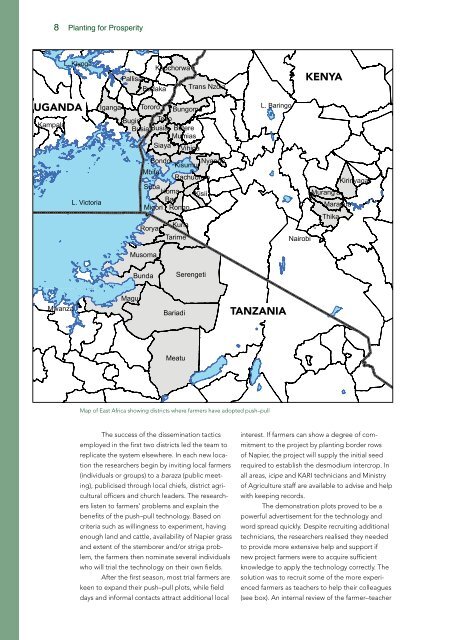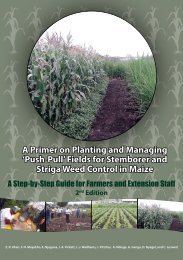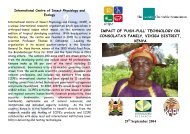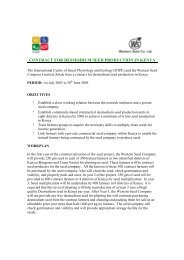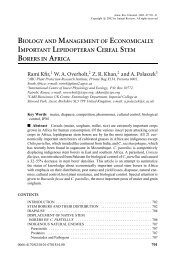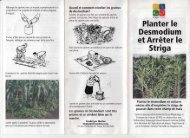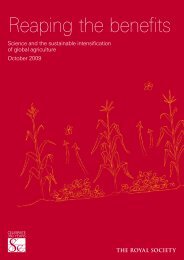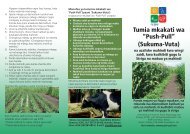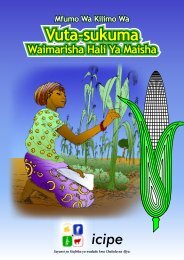a model for Africa's green revolution - Push-Pull
a model for Africa's green revolution - Push-Pull
a model for Africa's green revolution - Push-Pull
You also want an ePaper? Increase the reach of your titles
YUMPU automatically turns print PDFs into web optimized ePapers that Google loves.
8 Planting <strong>for</strong> Prosperity<br />
L. Kiyoga<br />
Kapchorwa<br />
Pallisa<br />
Budaka Trans Nzoia<br />
KENYA<br />
UGANDA<br />
Iganga Tororo Bungoma<br />
Bugiri Teso<br />
Kampala<br />
Busia Busia Butere<br />
"<br />
Mumias<br />
Siaya Vihiga<br />
"<br />
Bondo Nyando<br />
Kisumu<br />
Mbita<br />
" Rachuonyo<br />
Suba<br />
Homa Kisii<br />
L. Victoria<br />
Bay<br />
Migori Rongo<br />
Kuria<br />
Rorya<br />
Tarime<br />
L. Baringo<br />
Kirinyaga<br />
Murang'a<br />
Maragua<br />
Thika<br />
"<br />
Nairobi<br />
Musoma<br />
Bunda<br />
Serengeti<br />
Mwanza "<br />
Magu<br />
Bariadi<br />
TANZANIA<br />
Meatu<br />
Map of East Africa showing districts where farmers have adopted push–pull<br />
LEGEND<br />
The success of the dissemination tactics interest. If farmers can show a degree of commitment<br />
to the project by planting border rows<br />
District implementing push-pull technology<br />
employed in the first two districts led the team to<br />
Lake<br />
replicate the system elsewhere. In each new location<br />
the researchers begin by inviting local farmers<br />
of Napier, the project will supply the initial seed<br />
District<br />
required<br />
boundary<br />
to establish the desmodium intercrop. In<br />
(individuals or groups) to a baraza (public meeting),<br />
publicised through local chiefs, district agricultural<br />
all areas, icipe and KARI technicians and Ministry<br />
of Agriculture staff are available to advise and help<br />
officers and church leaders. The research-<br />
with keeping records. Km<br />
ers listen to farmers’ problems and explain 0 the 25<br />
benefits of the push–pull technology. Based on<br />
50 100The demonstration 150 200 plots proved to be a<br />
powerful advertisement <strong>for</strong> the technology and<br />
criteria such as willingness to experiment, having<br />
enough land and cattle, availability of Napier grass<br />
and extent of the stemborer and/or striga problem,<br />
the farmers then nominate several individuals<br />
who will trial the technology on their own fields.<br />
After the first season, most trial farmers are<br />
keen to expand their push–pull plots, while field<br />
days and in<strong>for</strong>mal contacts attract additional local<br />
word spread quickly. Despite recruiting additional<br />
technicians, the researchers realised they needed<br />
to provide more extensive help and support if<br />
new project farmers were to acquire sufficient<br />
knowledge to apply the technology correctly. The<br />
solution was to recruit some of the more experienced<br />
farmers as teachers to help their colleagues<br />
(see box). An internal review of the farmer–teacher


